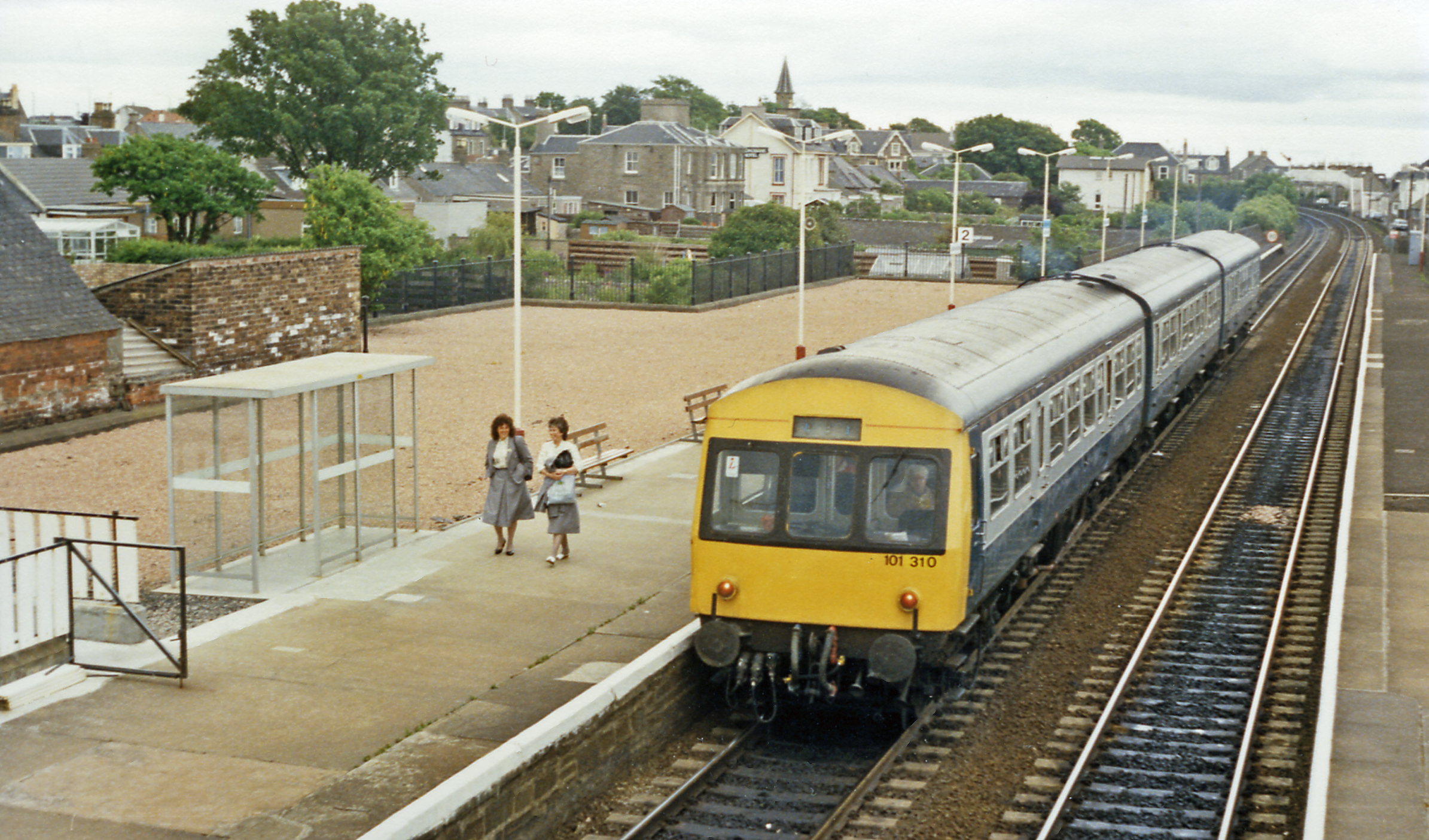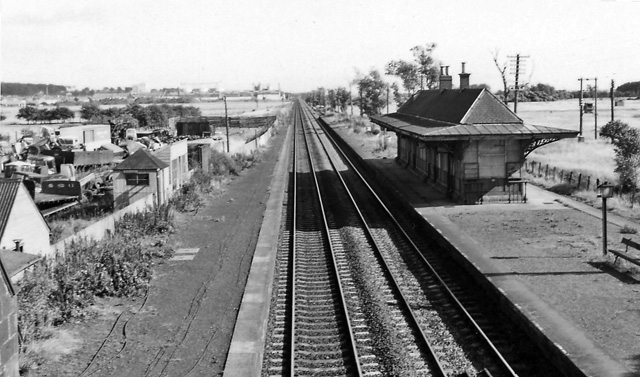|
Carnoustie Railway Station
Carnoustie railway station is a railway station which serves the town of Carnoustie, Angus, Scotland. It is sited east of the former Dundee East station, on the Dundee to Aberdeen line, between Golf Street and Arbroath. There is a crossover at the south end of the station, which can be used to facilitate trains turning back if the line north to Arbroath is blocked. ScotRail manage the station and provide almost all services. Carnoustie station was refurbished by Galliford Try Rail prior to the 2007 Open Golf Championship which was held at the adjacent golf course. History The station was opened on 6 October 1838 on the 5 ft 6 in (1,676 mm) gauge Dundee and Arbroath Railway. The station was originally built on the west side of Station Road, to the north of the running line. The goods yard was to the north of the station and mostly accessed via a turntable. The railway changed to standard gauge in 1847. In 1900 the station was relocated to the other side of the ... [...More Info...] [...Related Items...] OR: [Wikipedia] [Google] [Baidu] |
Carnoustie
Carnoustie (; ) is a town and former police burgh in the subdivisions of Scotland, council area of Angus, Scotland. It is at the mouth of the Barry Burn on the North Sea coast. In the UK census 2011, 2011 census, Carnoustie had a population of 11,394, making it the fourth-largest town in Angus. The town was founded in the late 18th century, and grew rapidly throughout the 19th century due to the growth of the local textile industry. It was popular as a tourist resort from the early Victorian era up to the latter half of the 20th century, due to its seaside location, and is best known for the Carnoustie Golf Links course that often hosts the Open Championship. Carnoustie can be considered a commuter town, dormitory town for its nearest city, Dundee, which is to the west. It is served principally by Carnoustie railway station, and also by Golf Street railway station. Its nearest major road is the A92 road, A92, north of the town. History Toponymy Carnoustie's name is of u ... [...More Info...] [...Related Items...] OR: [Wikipedia] [Google] [Baidu] |
Edinburgh Waverley Railway Station
Edinburgh Waverley (also known simply as Edinburgh; ) is the principal railway station serving Edinburgh, Scotland. It is the second busiest station in Scotland, after Glasgow Central. The station serves as the northern terminus of the East Coast Main Line, from , although some trains operated by London North Eastern Railway continue to other Scottish destinations beyond Edinburgh. History Origins Edinburgh's Old Town, perched on a steep-sided sloping ridge, was bounded on the north by a valley in which the Nor Loch had been formed. In the 1750s overcrowding led to proposals to link across this valley to allow development to the north. The "noxious lake" was to be narrowed into "a canal of running water", with a bridge formed across the east end of the loch adjacent to the physic garden. This link was built from 1766 as the North Bridge and at the same time plans for the New Town began development to the north, with Princes Street to get unobstructed views south over slopi ... [...More Info...] [...Related Items...] OR: [Wikipedia] [Google] [Baidu] |
Railway Stations Served By ScotRail
Rail transport (also known as train transport) is a means of transport using wheeled vehicles running in tracks, which usually consist of two parallel steel rails. Rail transport is one of the two primary means of land transport, next to road transport. It is used for about 8% of passenger and freight transport globally, thanks to its energy efficiency and potentially high speed.Rolling stock on rails generally encounters lower frictional resistance than rubber-tyred road vehicles, allowing rail cars to be coupled into longer trains. Power is usually provided by diesel or electric locomotives. While railway transport is capital-intensive and less flexible than road transport, it can carry heavy loads of passengers and cargo with greater energy efficiency and safety. Precursors of railways driven by human or animal power have existed since antiquity, but modern rail transport began with the invention of the steam locomotive in the United Kingdom at the beginning of the 19th ... [...More Info...] [...Related Items...] OR: [Wikipedia] [Google] [Baidu] |
Former Dundee And Arbroath Railway Stations
A former is an object, such as a template, gauge or cutting die, which is used to form something such as a boat's hull. Typically, a former gives shape to a structure that may have complex curvature. A former may become an integral part of the finished structure, as in an aircraft fuselage, or it may be removable, being used in the construction process and then discarded or re-used. Aircraft formers Formers are used in the construction of aircraft fuselage, of which a typical fuselage has a series from the nose cone to the empennage, typically perpendicular to the longitudinal axis of the aircraft. The primary purpose of formers is to establish the shape of the fuselage and reduce the column length of stringers to prevent instability. Formers are typically attached to longerons, which support the skin of the aircraft. The "former-and-longeron" technique (also called stations and stringers) was adopted from boat construction, and was typical of light aircraft built until t ... [...More Info...] [...Related Items...] OR: [Wikipedia] [Google] [Baidu] |
Railway Stations In Angus, Scotland
Rail transport (also known as train transport) is a means of transport using wheeled vehicles running in tracks, which usually consist of two parallel steel rails. Rail transport is one of the two primary means of land transport, next to road transport. It is used for about 8% of passenger and freight transport globally, thanks to its energy efficiency and potentially high speed.Rolling stock on rails generally encounters lower frictional resistance than rubber-tyred road vehicles, allowing rail cars to be coupled into longer trains. Power is usually provided by diesel or electric locomotives. While railway transport is capital-intensive and less flexible than road transport, it can carry heavy loads of passengers and cargo with greater energy efficiency and safety. Precursors of railways driven by human or animal power have existed since antiquity, but modern rail transport began with the invention of the steam locomotive in the United Kingdom at the beginning of the 19th ... [...More Info...] [...Related Items...] OR: [Wikipedia] [Google] [Baidu] |
Barry Links Railway Station
Barry Links railway station lies south of the village of Barry, west of Carnoustie in Angus, Scotland. It is sited from the former Dundee East station, and is on the Dundee to Aberdeen line, between Monifieth and Golf Street. The station is managed by ScotRail, who provide all the services at the station. In 2016/17, Barry Links was the least used railway station in the UK with just 24 entries and exits. History The station was opened on 31 July 1851 by Dundee and Arbroath Railway, and was named Barry,Butt, page 28 even though the line through the station had opened thirteen years earlier. The station was renamed to its current name on 1 April 1919, presumably to avoid confusion with Barry station, in South Wales. Facilities Both platforms have shelters and benches, whilst platform 2 also has cycle racks. Only platform 2 has step-free access. As there are no facilities to purchase tickets, passengers must buy one in advance, or from the conductor on the train. Passe ... [...More Info...] [...Related Items...] OR: [Wikipedia] [Google] [Baidu] |
West Coast Main Line
The West Coast Main Line (WCML) is one of the most important railway corridors in the United Kingdom, connecting the major cities of London and Glasgow with branches to Birmingham, Manchester, Liverpool and Edinburgh. It is one of the busiest mixed-traffic railway routes in Europe, carrying a mixture of intercity rail, regional rail, commuter rail and rail freight traffic. The core route of the WCML runs from London to Glasgow for approx. and was opened from 1837 to 1881. With additional lines deviating to Northampton, Birmingham, Manchester, Liverpool and Edinburgh, this totals a route mileage of . The Glasgow–Edinburgh via Carstairs line connects the WCML to Edinburgh. However, the main London–Edinburgh route is the East Coast Main Line. Several sections of the WCML form part of the Urban rail in the United Kingdom, suburban railway systems in London, Coventry, Birmingham, Manchester, Liverpool and Glasgow, with many more smaller commuter stations, as well as providing li ... [...More Info...] [...Related Items...] OR: [Wikipedia] [Google] [Baidu] |
West Highland Line
The West Highland Line ( – "Iron Road to the Isles") is a railway line linking the ports of Mallaig and Oban in the Scottish Highlands to Glasgow in Central Scotland. The line was voted the top rail journey in the world by readers of independent travel magazine ''Wanderlust'' in 2009, ahead of the notable Trans-Siberian Railway, Trans-Siberian line in Russia and the PeruRail#Cusco_-_Aguas_Calientes_.28Machu_Picchu.29, Cuzco to Machu Picchu line in Peru. The ScotRail website has since reported that the line has been voted the most scenic railway line in the world for the second year running. The West Highland Line is one of two railway lines that access the remote and mountainous west coast of Scotland, the other being the Kyle of Lochalsh Line which connects Inverness with Kyle of Lochalsh. The line is the westernmost railway line in Great Britain. At least in part, the West Highland Line is the same railway line as that referred to as the West Highland Railway. History The ... [...More Info...] [...Related Items...] OR: [Wikipedia] [Google] [Baidu] |
Highland Main Line
The Highland Main Line is a railway line in Scotland. It is long and runs through the central Scottish Highlands, mainly following the route of the A9 road (Scotland), A9, and linking a series of small towns and villages with Perth, Scotland, Perth at one end and Inverness at the other. Today, services between Inverness and Edinburgh, Glasgow and London use the line. At Inverness the line connects with the Far North Line, the Aberdeen to Inverness Line, Aberdeen-Inverness Line and the Kyle of Lochalsh Line. Much of the Highland Main Line is Single track (rail), single track, and trains coming in opposite directions are often timed to arrive at stations at the same time, where Passing loop, crossing loops permit them to pass. Journey times between Inverness and Edinburgh or Glasgow are approximately three and a half hours.Highland Main Line timetables at https://www.scotrail.co.uk/sites/default/files/assets/download_ct/edinburgh_glasgow_-_inverness_0.pdf History The vast ... [...More Info...] [...Related Items...] OR: [Wikipedia] [Google] [Baidu] |








